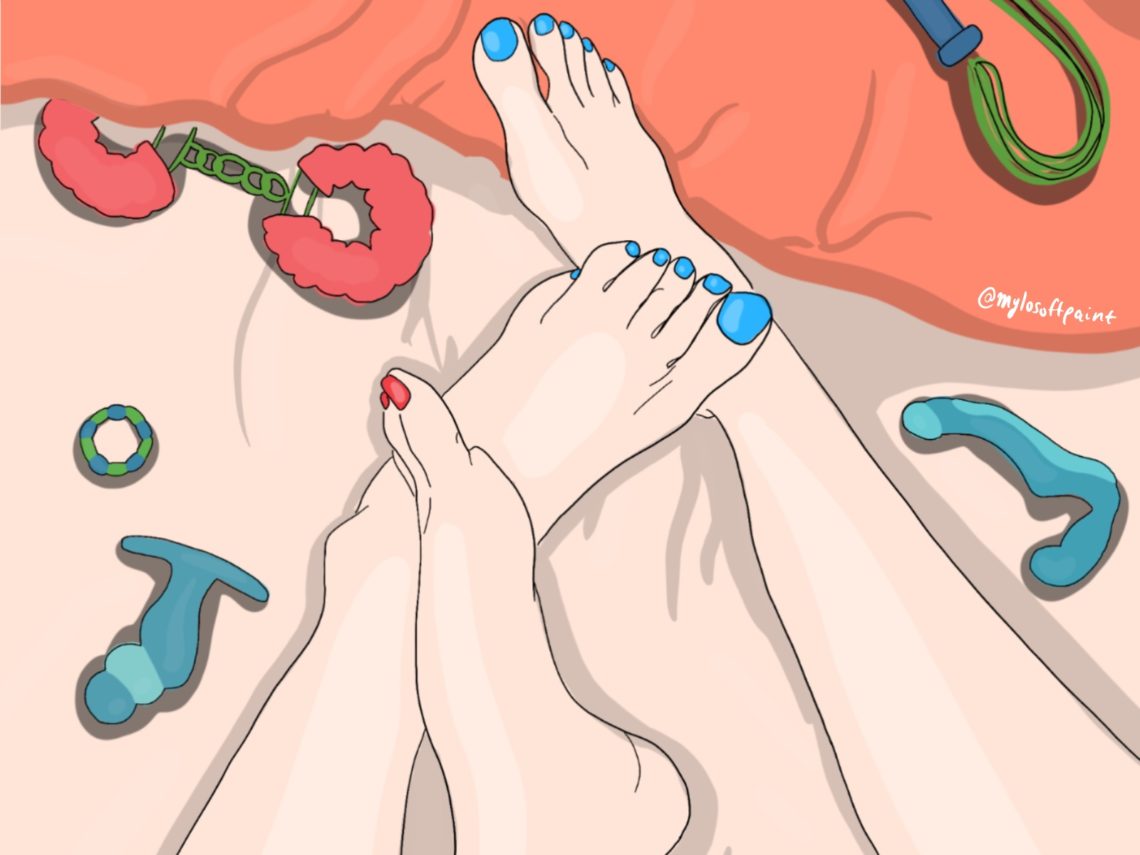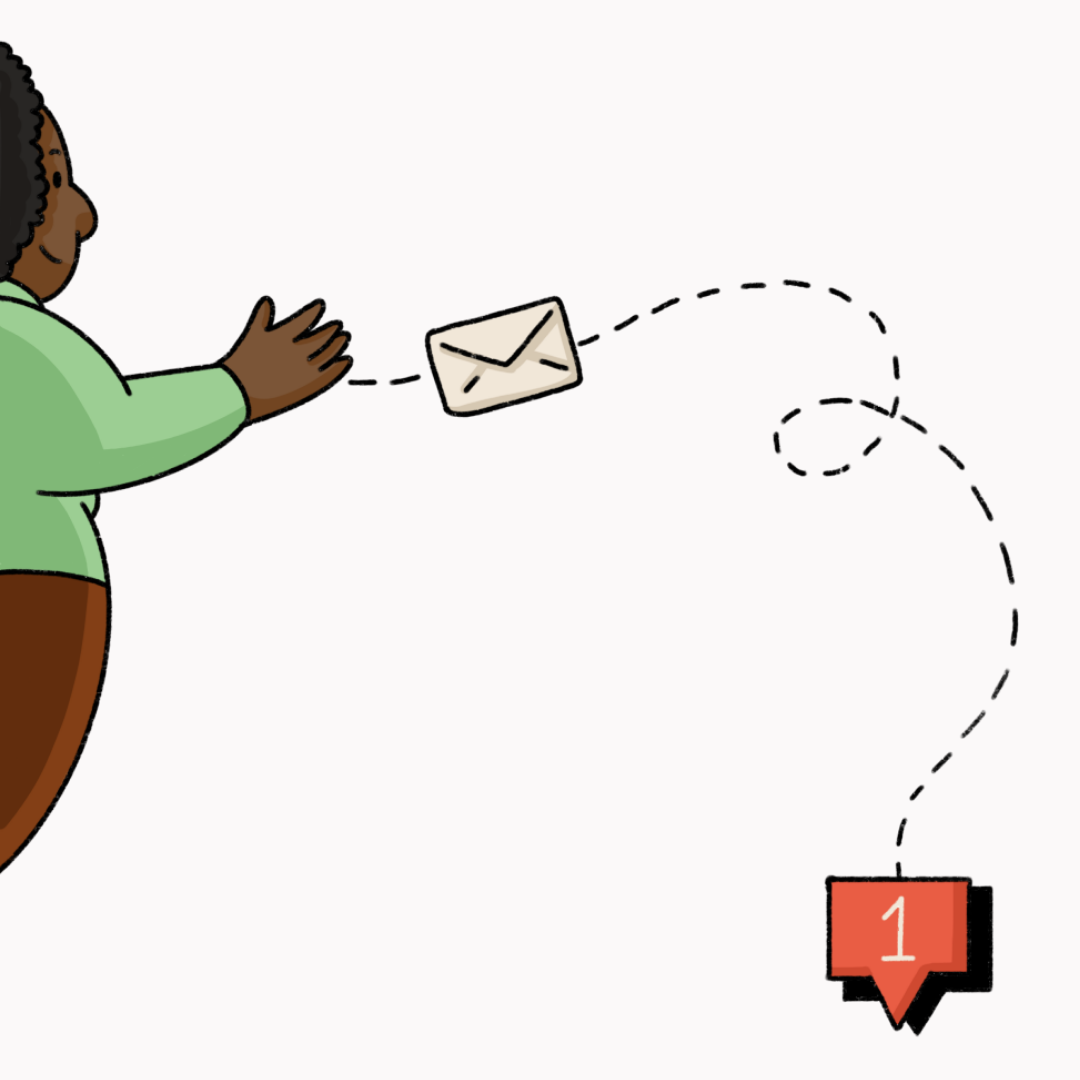Written by: Geneviève Gill (she/her).
Edited by: Étienne Maes (he/him).
I love talking about sex. Relationships, preferences, attractions, “vibes”, you name it. Ultimately, isn’t that a big part of how we learn: through conversing about sex, sharing experiences, and listening to others? Recently, sex toys have come up a lot in conversation. Years ago, had you asked me if I saw myself in harnesses, lace, or fur, or browsing brightly coloured dildos, butt plugs, and strings of anal beads on some website, I would have likely responded that “it’s just not for me”. Ask me this question today, and I would rethink my answer.
A small disclosure as I write about my experiences: I’m still navigating my own, very new, exploration into the world of sex toys. In no world am I an expert, nor include all toys on the market in this piece. I also acknowledge that the toys I’ve entertained suit my body and the type of sex I partake in. I will, however, share the small steps I’ve taken through what we’ll call my “escaping-complacent-sex” phase, in the hopes of breaking down sex toy stigma and normalizing the conversation around pleasurable sex.
My first encounter with sex toys was when using a dress tie with a partner.
My first encounter with sex toys was when using a dress tie with a partner. Why not? It was lying on his bedroom floor and I’d seen people do this in movies. He tied my arms together and secured them to the bedpost. It was hot and exciting, but I also felt oddly guilty for incorporating something external into our sex life. Other than a handful of times we played with a dress tie, we had sex solely with our bodies. I remember thinking “we can both orgasm from sex without batting an eye. What more could I need during sex?”. I truly had no idea what we were missing out on, and clearly had to rethink my relationship with sex, if orgasms were the only metric of a strong, healthy sex life.
Years later, a partner suggested we use her vibrator together during sex. I had always associated vibrators with masturbation, so using it together was new to me. At that point in my life, I had much more experience sleeping with men, and therefore felt somewhat lost in terms of queer sex. This feels like an opportune moment to point out that there are very few accessible sources of information when it comes to queer sexual education (1). People can learn from other queer folks, various forms of literature, porn, and perhaps a reductive Hollywood interpretation, but exposure to queer sexuality seems much more restrictive than any heterosexual discourse. I felt like I was back on training wheels. Any opportunity to explore during sex felt nerve-racking, but important. We ended up shopping for vibrators together online and picked a toy that both applied suction to the clitoris to simulate oral sex and had a vibrating dildo you insert inside your vagina to simulate penetration. We used it together and on each other. It was mind blowing. Perhaps it was the sensation from the object itself, or the excitement of being in an exploratory phase of sex. Regardless, I was hooked.
Any opportunity to explore during sex felt nerve-racking, but important.
New partners brought forth different ideas, needs, and desires to the table. I started researching other toys. There was so much out there, but I had no idea where to start. I had a bunch of different toys pending in my online cart on various websites. What sites were legitimate? What toys would I like? I was too nervous to hit that “pay now” button. I thought I knew what I liked during sex, but obviously, as I was learning, there was so much uncharted territory.
I still had many stigmas to break down around sex toys. The way they were advertised did not appeal to me. I felt like I was doing something illegal by browsing for them. I would search on incognito mode or would clear my browsing history afterwards. I found myself strictly associating sex toys with bondage, discipline, dominance, submission, and sadomasochism (BDSM); which for the record, can incorporate toys and other objects during sex but is only a portion of toy play. For years, harnesses and straps scared me. I was worried I would come across as too aggressive, masculine, kinky even, if I presented them in the bedroom to partners. The current me sits here wondering “what’s so wrong about coming across that way?”. Clearly, I had some work cut out for me with respect to my relationship with sex, kinks, my gender expression. The list goes on.
Once I was able to explore new types of relationships and remove myself from more complacent sex, I was able to focus on pleasure.
An interesting realization occurred as my relationship with sex grew stronger, while I began having sex with people of different genders and exploring various relationship styles. During this time, I was doing a lot of questioning about my attractions, fantasies, and boundaries. Once I was able to explore new types of relationships and remove myself from more complacent sex, I was able to focus on pleasure. I could be selfish during sex. This realization that a woman could focus on herself and her own enjoyment during sex, while also providing pleasure to another person was pivotal. I was always aware of the importance of empowering women and actively practicing it in its various forms. I’d seen this written in a pretty font on a post from the more progressive Instagram accounts I follow, heard it in song lyrics, and quite frankly, put it into practice in other areas of my life. It was only until I applied this philosophy to my sex life that I truly understood the weight of these words.
It took one partner to fully sell me on sex toys — my very own Santa Claus of the sex toy world, showing up at my place with a bag full of toys. We quickly developed an intentional and effective dialogue about our interests and limits. She helped normalize toys with me by educating me on what she owns and the toys she is interested in procuring. She offered to take me shopping for sex toys for my birthday. Through this, I have been able to embrace the “figuring it out” phase, as we try various toys, and find positions that feel good for us. There’s an awkwardness to toys falling out unexpectedly, or certain positions seeming almost comical, but that’s what makes sex humanizing. I realized that once I’d broken down these stigmas around sex toys, sex can be ridiculously exciting. More so than I ever thought.
I realized that once I’d broken down these stigmas around sex toys, sex can be ridiculously exciting.
Hypothetically, say we’ve broken down some stigmas, we still haven’t solved the problem about the lack of knowledge around sex toys (and I recognize these two are tightly intertwined). How do you shop for what’s right for you? How do you practice safe sex with toys? How do you introduce sex toys into the bedroom?
I had a FaceTime call with a friend who was talking to me about butt plugs and dildos. Based on his own experience with toys, he was reminding me that the quality of the toy was important, including the material it is made from, which can determine whether someone will choose a silicone toy or a household item. He then proceeded to explain how different lubes work with different materials and that there are very specific hygiene practices. How was it that I had never considered these things?
I dove into a research spiral and came across some important hygiene information.
Research studies have shown the importance of using barriers with sex toys, such as condoms, and washing toys in between uses to avoid HPV, bacterial vaginosis and candida (yeast) infections (2, 3, 4). This includes cleaning the toy between uses, partners, and when switching between oral, anal, and vaginal use. Cleaning methods vary with each toy and the material they’re made of. Often, people will use a specific toy with the same partner for similar hygiene purposes. Sex toy practice is at the top of my list for the next conversation with my gynecologist.
In my experience, sex toys were never spoken about in school. The list of what information is lacking in sexual education courses is extensive: queer sex, appropriate contraceptive methods, consent, masturbation, and pleasure — in the form of sex toys. Teaching about the use of certain tools during sex not only places emphasis on the importance of enjoyment but can also allow for safer sexual experiences. It allows sex to be more inclusive, destigmatizes kinks and fantasies, and can improve countless relationships.
So, I encourage you to have a conversation with yourself. What do you enjoy? What piques your interest during sex? Embrace your preferences. Are there none that jump out at you? Talk about it with your partner(s). Buy yourself a toy, and normalize sex toy talk. At the end of the day, sex should be a very positive experience, and your sexual health is equally important to advocate for.
References:
1. Gowen L, Winges-Yanez N. Lesbian, Gay, Bisexual, Transgender, Queer, and Questioning Youths’ Perspectives of Inclusive School-Based Sexuality Education. The Journal of Sex. Research. 2013;51(7):788-800.
2. Marrazzo J, Koutsky L, Eschenbach D, Agnew K, Stine K, Hillier S. Characterization of Vaginal Flora and Bacterial Vaginosis in Women Who Have Sex with Women. The Journal of Infectious Diseases. 2002;185(9):1307-1313.
3. McNair R. Risks and prevention of sexually transmissible infections among women who have sex with women. Sexual Health. 2005;2(4):209.
4. Wood J, Crann S, Cunningham S, Money D, O’Doherty K. A cross-sectional survey of sex toy use, characteristics of sex toy use hygiene behaviours, and vulvovaginal health outcomes in Canada. The Canadian Journal of Human Sexuality. 2017;26(3):196-204.



